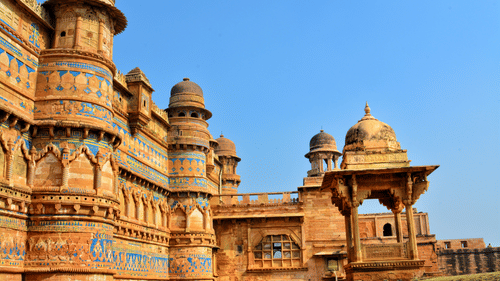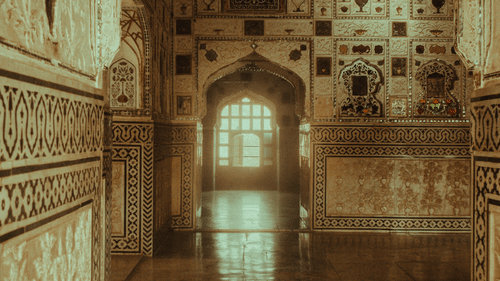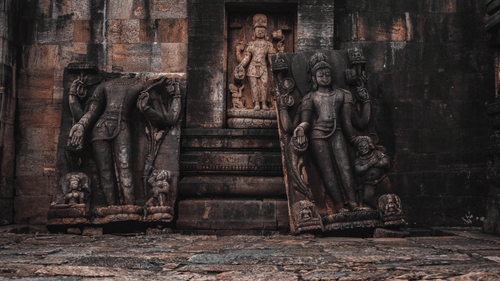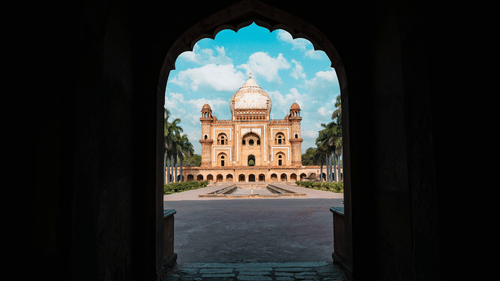Places to Visit in Gwalior
Gwalior, the historical heart of Madhya Pradesh, is a city where the past resonates in every corner, where architectural marvels and rich heritage await your exploration. It's a destination that beckons travellers with a promise of unforgettable experiences. In this comprehensive guide, we will lead you through the best places to visit in Gwalior and the reasons why you should make this city your next travel destination.

Gwalior Fort
Our journey commences with the iconic Gwalior Fort, a true gem among the best places to visit in Gwalior. Perched majestically on a hilltop overlooking the city of Gwalior, this fort offers awe-inspiring panoramic views of the surrounding landscape. This fort has been built and rebuilt over many centuries by different rulers, the earliest parts of the fort date back to the 6th century AD, a testament to its enduring significance in India's history. Throughout the ages, Gwalior Fort has witnessed the rise and fall of dynasties, passing from the hands of the Gurjara-Pratiharas to the Tomar Rajputs, and later into the dominion of the mighty Mughals. Finally, the Scindias, one of the most prominent Maratha families, held sway over this historic site. The fort is a treasure trove of palaces, temples and other historical buildings, each echoing the whispers of centuries gone by.

Jai Vilas Palace
A short journey from the fort leads you to Jai Vilas Palace, a beautiful example of Rajput architecture. This magnificent palace was constructed during the reign of Maharaja Jayaji Rao Scindia in the 19th century, now gracefully transformed into a museum, offering visitors a chance to step back in time and immerse themselves in the grandeur of royal India. The exterior of the palace is decorated with intricate carvings and the interior of the palace is lavishly decorated with marble, gold and paintings. The palace boasts a series of rooms, The Durbar Hall, where the Scindias once held court, The Throne Room, where the Scindias sat on their thrones and The Ballroom, where the Scindias held grand balls and receptions. The palace also has a number of other features, including a library, a museum and a theatre making Jai Vilas Palace a must-visit for anyone interested in Indian history and culture.

Sasbahu Temple
Exploring Gwalior's historical and architectural wonders wouldn't be complete without a visit to Sas Bahu Temple. This twin temple, dating back to the 11th century, is dedicated to the Hindu goddesses Durga and Lakshmi. Made from red sandstone and adorned with intricate carvings, the larger temple, Sas Mandir is dedicated to Durga, while the smaller one, Bahu Mandir is dedicated to Lakshmi. Representing a fine example of early Hindu temple architecture, the temple's carvings narrate tales from Hindu mythology, such as Ramayana and Mahabharata.

Teli Ka Mandir
Teli Ka Mandir, also known as Telika Temple, stands within the Gwalior Fort as a notable Hindu temple. It is dedicated to Shiva, Vishnu and the Matrikas, with its construction believed to date back to the early 8th or 9th century CE. It departs from the typical Hindu temple design, featuring a rectangular sanctum instead of the more common square layout. The name "Teli Ka Mandir" originates from the Teli community, traditionally oil-pressers. Local legend attributes the temple's construction to this community, although historical evidence supporting this claim is absent. Nevertheless, the temple serves as a fine example of early Hindu temple architecture. Made from sandstone, the temple's exterior boasts intricate carvings depicting scenes from Hindu mythology, including episodes from the Ramayana and the Mahabharata. This temple is one of the best tourist places in Gwalior and for the right reasons.

Tomb of Tansen
The Tomb of Tansen, located in Gwalior, is a mausoleum dedicated to the renowned Indian musician Tansen, who served as one of the nine esteemed individuals in the court of Mughal emperor Akbar. This 16th-century tomb was constructed by Tansen's son, Bilas Khan, and stands as a simple yet graceful structure that aptly honours Tansen's lasting legacy. Comprising two sections, the tomb includes a main chamber, where Tansen's remains are laid to rest. This chamber is a modest, square room featuring a domed ceiling. Adjacent to it is the antechamber, a larger space where visitors can offer their respects to the musical maestro. The tomb's adornments include intricate carvings of flowers, birds and animals while the walls of the main chamber bear inscriptions of verses from the Quran. This historical site attracts tourists interested in Indian history and culture, providing a tranquil space to pay homage to Tansen's profound contributions to the world of music.
To make the most of your visit to Gwalior, we recommend staying at Deo Bagh - 17th Century, Gwalior, where heritage meets modern comfort. We offer the perfect blend of luxury and history. Located conveniently near the best places to visit in Gwalior, you'll find yourself immersed in the city's charm. Our heritage hotel offers a range of well-appointed rooms, each facing a Nau Bagh. Our hotel's warm and attentive staff are dedicated to ensuring your stay is nothing short of extraordinary. Read our blog to learn about the best time to visit Gwalior.